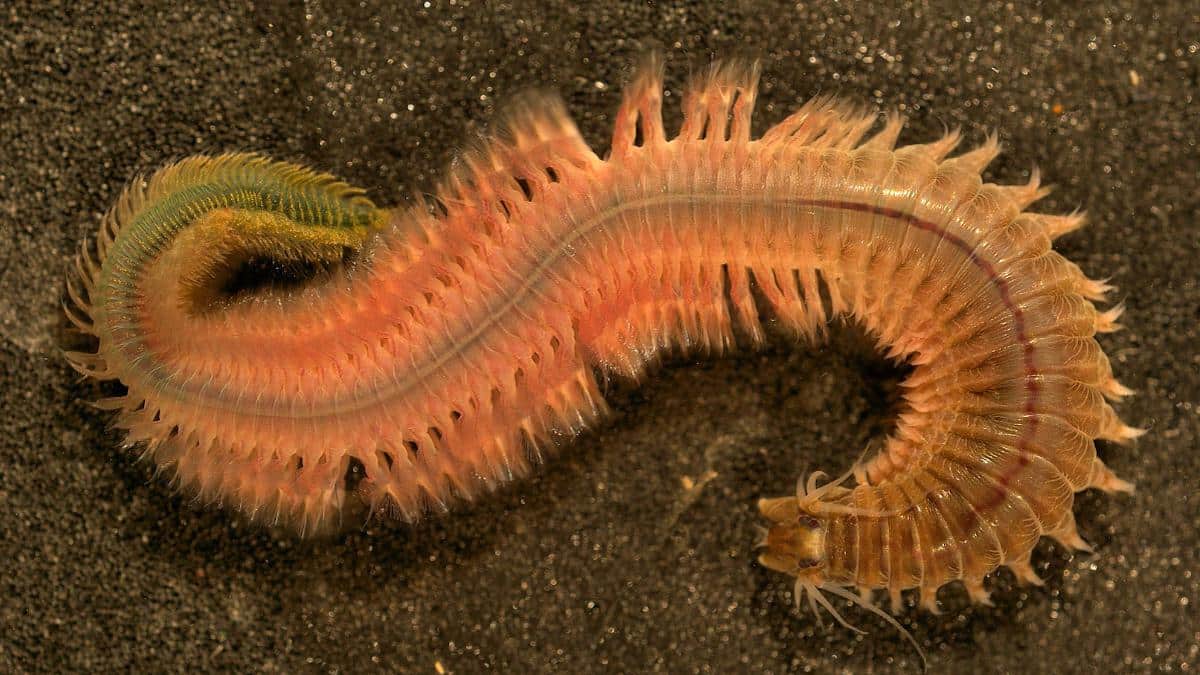

A clam worm as an epitoke, its reproductive form. © Hans Hillewaert / CC BY-SA 4.0
Spring brings many changes: longer days, new blooms and swarms of predatory marine worms?
The South Carolina Department of Natural Resources (SCDNR) posted a video April 14 of coastal waters teaming with round, pink worms.
“Sometimes called clamworms, these animals that ordinarily live on the seafloor undergo an incredible transformation under new and full moons in spring – their bodies morph into reproductive forms called ‘epitokes’ as they swarm in coastal waters,” the agency wrote.
EDIT: See our 4/27 post for an update — these swarms disappear within days, happen when water temperatures are still cool and pose no threat to people. Most folks will never see them, so enjoy these glimpses of an interesting spring event!Nothing says spring on the coast like… a frenzy of marine worms? 🐛🐛🐛Sometimes called clamworms, these animals that ordinarily live on the seafloor undergo an incredible transformation under new and full moons in spring – their bodies morph into reproductive forms called ‘epitokes’ as they swarm in coastal waters. This fascinating phenomenon occurs every year at our marine headquarters in Charleston and is often followed by hungry throngs of fish and birds along the marsh edge. 🐟🦅You may not want to go swimming with epitokes, as clamworms do have a set of hooked jaws, but it’s hard not to appreciate such an unusual coastal sight. 🏝️Have you ever seen an epitoke swarm in spring?
Posted by South Carolina Department of Natural Resources on Wednesday, April 14, 2021
This phenomenon occurs every year at the agency’s marine headquarters in Charleston, South Carolina and is a boon to other wildlife, as fish and birds gather to feast on the teaming worms. However, the worms are not defenseless.
“You may not want to go swimming with epitokes, as clamworms do have a set of hooked jaws,” SCDNR wrote.
In fact, those jaws are strong enough to break human skin, WBTW reported. The worms also have lips, a mouth and two pairs of eyes. They can grow to be up to seven and a half inches long, according to Texas A&M University at Galveston.
Common clam worms are also called pile worms and are scientifically referred to as Alitta succinea. They are not unique to South Carolina. In fact, they are considered an invasive species because of how easily they spread, according to CABI‘s Invasive Species Compendium.
“The native range of A. succineais thought to be along the Atlantic coast of Europe, though it is now present in many parts of the world,” CABI wrote. “Populations in the North Sea, Mediterranean Sea and Black Sea coasts may be native or may have been introduced with the earliest shipping. Many other populations in eastern Asia, Africa, and Central and South America are considered cryptogenic by many authors, though are likely to have been introduced with the advent of intercontinental shipping. It is known to be introduced to Australia and the Pacific coast of North America and Hawaii. It is likely to be more widespread than indicated.”
Clam worms are common in ports and estuaries. They can impact native species by competing with them for food or by altering the nutrients available in the sediment when they burrow. This can increase bacterial activity and move contaminants from the sediment up the marine food chain.
The surface swarming observed in South Carolina this spring is the end of the clam worm’s life cycle. The worms only survive as epitokes for a few days and die shortly after spawning. Within 36 hours, their eggs develop into small, plankton-eating larvae. Once the larvae develop enough, they return to the sediment to burrow and start the process all over again.
While some commenters found the swarming worms disturbing, SCDNR has a more positive approach.
“[I]t’s hard not to appreciate such an unusual coastal sight,” the agency wrote.

 233k
233k  41k
41k  Subscribe
Subscribe 